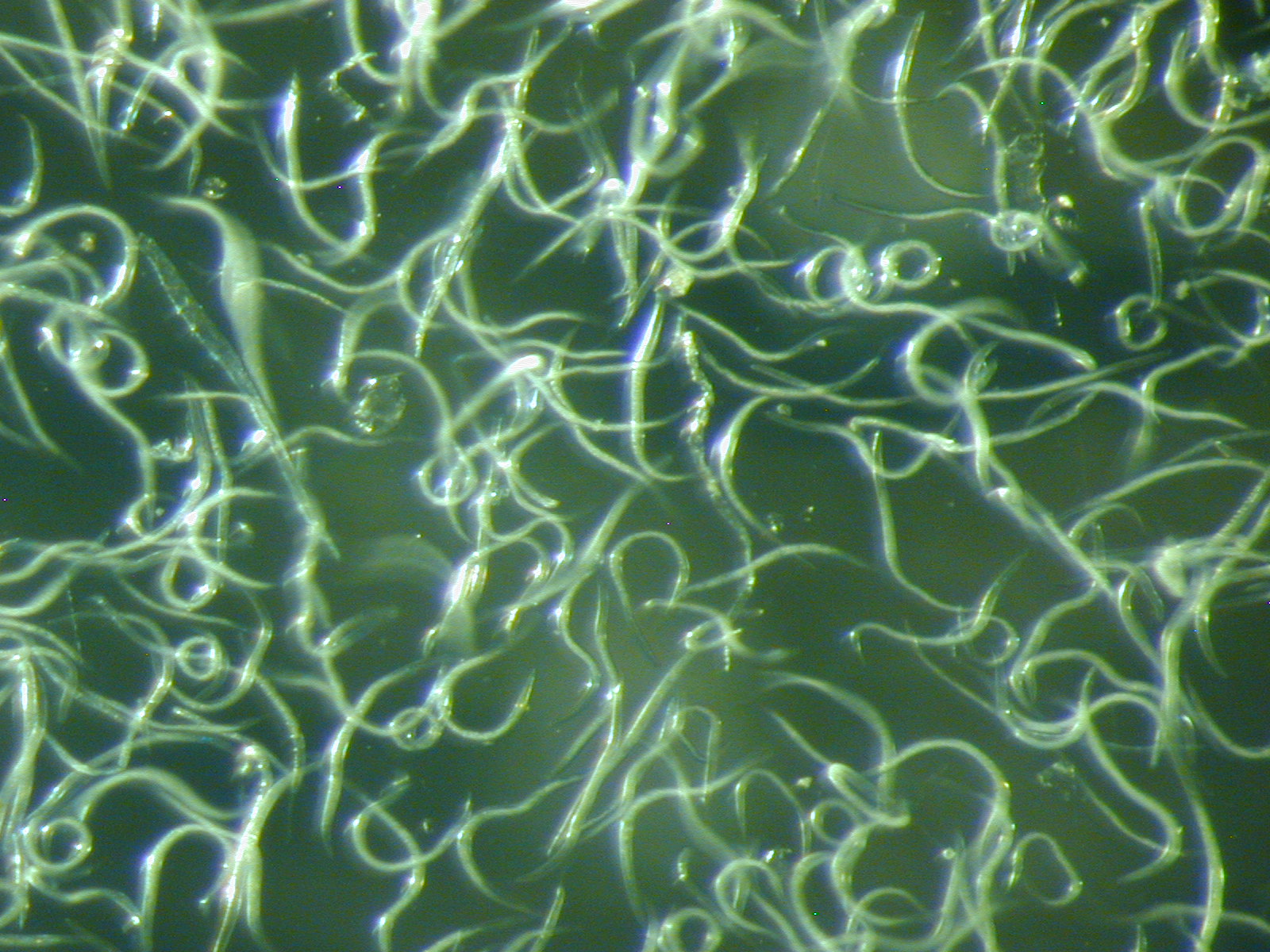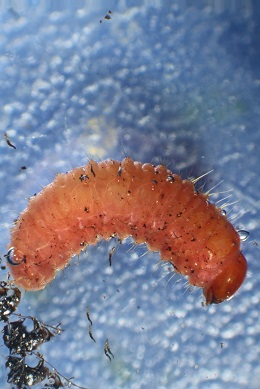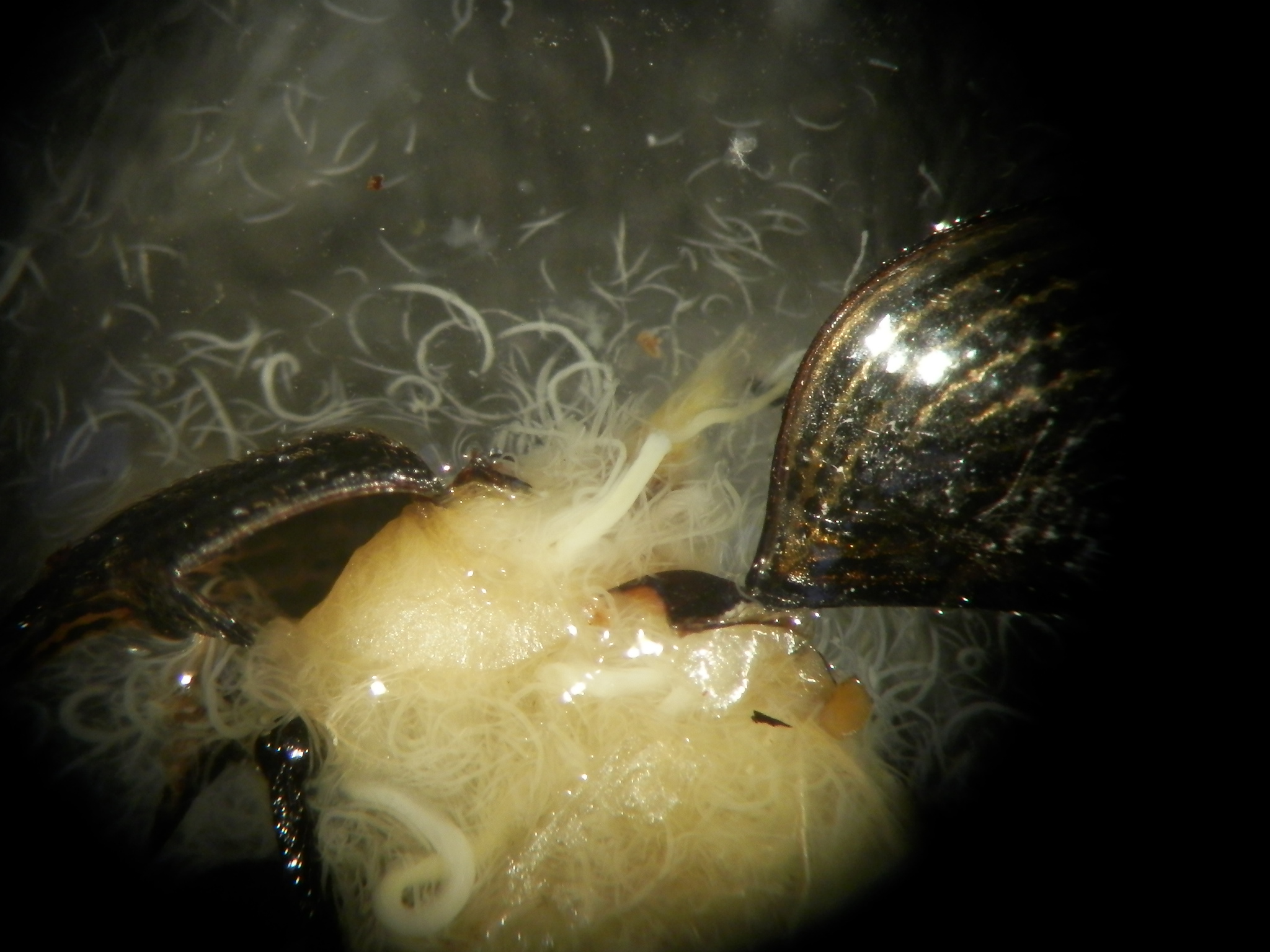Please click here to access the main AHDB website and other sectors.
- Home
- Knowledge library
- Vine weevil in soft fruit: Biological control – nematodes
Vine weevil in soft fruit: Biological control – nematodes
On this page, find comprehensive guidance to using nematodes as an effective control of vine weevil in soft fruit.
This information was last updated in 2018.
Please read the disclaimer at the bottom of this page
Go back to the main page: Vine weevil control in soft fruit
Entomopathogenic nematodes
Entomopathogenic nematode products (microscopic worms) are sold commercially in an inert carrier.
 RSK ADAS
RSK ADAS
Figure 1. Entomopathogenic nematodes in water seen under a microscope.
When received, the nematodes are in a semi-desiccated state, but they quickly hydrate and revive when water is added.
Once applied to moist growing media or soil, the infective juveniles swim short distances to find vine weevil larvae or pupae, homing in on carbon dioxide or exudates released by weevil-damaged roots.
The nematodes cannot swim long distances, so need to be applied to the target area where vine weevil larvae or pupae are located around the roots.
Once the juvenile nematodes have found their host, they enter its body through natural openings such as the mouth or anus.
Symbiotic bacteria
Heterorhabditis species can also penetrate the host insect cuticle using a tooth. Once inside the body, the nematodes release symbiotic bacteria that they carry in their gut.
Steinernema nematode species carry Xenorhabdus species of bacteria and Heterorhabditis species carry Photorhabdus species of bacteria.
These bacteria then multiply within the vine weevil and kill it by septicaemia within a few days.
Infective juveniles
The multiplying bacteria provide suitable conditions inside the vine weevil body for the nematodes to grow into adults and reproduce.
This leads to a new generation of infective juveniles that leave the disintegrated vine weevil cadaver to find more vine weevil larvae or pupae to infect.
Species and products
In the UK, commercially available nematode products contain Steinernema kraussei, Heterorhabditis bacteriophora, Heterorhabditis downesi or a mix of species (see Table 1).
|
Nematode species |
Product name |
Producer/supplier |
Temperature range |
Comments |
|
Steinernema kraussei
|
Nemasys L |
BASF |
5-30°C |
|
|
S. kraussei
|
Exhibitline sk |
Bioline AgroSciences Ltd. |
5-30°C |
|
|
S. kraussei
|
Kraussei-System |
Biobest |
5-30°C |
|
|
Steinernema feltiae |
Entonem |
Koppert |
8-33°C |
|
|
Heterorhabditis bacteriophora
|
Exhibitline h |
Bioline AgroSciences Ltd. |
12-30°C |
|
|
H. bacteriophora |
Nemasys H |
BASF
|
12-30°C |
|
|
H. bacteriophora |
Nematop |
e-nema |
above 12°C for several hrs per day
|
|
|
H. bacteriophora |
Larvanem |
Koppert
|
14-33°C |
|
|
H. bacteriophora |
NemaTrident-H |
Bionema |
12-28°C |
Recommended with a ‘soil conditioner’ (Transformer®) |
|
Heterorhabditis downesi |
NemaTrident-CT |
Bionema |
8-28°C |
Recommended with a ‘soil conditioner’ (Transformer®) |
|
A mix of Steinernema carpocapsae, S. feltiae and either H. bacteriophora or H. megidis |
SuperNemos |
Flowering Plants Ltd. |
above 10°C |
Marketed for control of a range of insect species in one application e.g. vine weevil larvae, leatherjackets and sciarid fly larvae |
|
A mix of H. bacteriophora and S. feltiae |
NemaTrident-CT Plus |
Bionema |
8-28°C |
Recommended with a ‘soil conditioner’ (Transformer®) |
Table 1. Available nematode species and products for vine weevil control and soil or growing media temperature ranges. Please check the latest regulations before use.
- Steinernema kraussei products are particularly useful for spring and late autumn applications as this nematode species is effective at soil or growing media temperatures down to 5°C.
- All nematode species are effective at temperatures up to 28-33°C depending on product (Table 1).
- Vine weevil larvae infected with Heterorhabditis species turn a red colour (see figure 2), whereas those infected with Steinernema species turn a less noticeable yellow-brown colour.
- However, infected larvae killed by both nematode species disintegrate very quickly after death.
- Using numbers of live larvae remaining a few weeks after treatment is, therefore, a more reliable guide to the level of control achieved than trying to count infected larvae.
 RSK ADAS
RSK ADAS
Figure 2. Vine weevil larva infected with Heterorhabditis bacteriophora has turned a red colour.
- However, infected larvae killed by both nematode species disintegrate very quickly after death.
- Using numbers of live larvae remaining a few weeks after treatment is, therefore, a more reliable guide to the level of control achieved than trying to count infected larvae.
Application – timing and frequency
Nematodes should be applied for curative control when larvae are present in the growing media.
They will also control weevil pupae. As eggs can be laid for a protracted period, from April (from overwintered adults) or from June (new adults) through to October or November under protection, larvae could be present at any time of year.
Most soft fruit growers apply nematodes during late August and early September when most eggs will have been laid and larvae of various ages will be present, whilst substrate or soil temperatures are suitable for the nematodes to work (see Table 1).
Application timing
It is a good idea to order nematodes for this application timing in advance to ensure supply.
The nematodes only persist in the substrate or soil in sufficient numbers to kill larvae for up to four weeks after application (as long as conditions are suitable). Therefore, it is advisable to make a second autumn application, two to four weeks after the first (depending on the timing of the first application and the substrate or soil temperatures), to control larvae hatching from later-laid eggs and to control any that were not killed by the first application.
It is very important to select a nematode product that will be effective at substrate or soil temperatures not only at the time of application but also for up to four weeks after application, to allow time for the nematodes to work.
Measure temperature
A temperature probe should be used to measure substrate or soil temperature.
It is also important to apply nematodes to strawberry crops before the larvae have burrowed into the crowns, when it is more difficult for the nematodes to reach the larvae.
The other ‘window’ for nematode application is in April/early May to control overwintered larvae and pupae, but product selection and timing is critical to target applications when substrate temperatures are warm enough for the nematodes but before adults start emerging from pupae. This application time is suitable for spring re-planted strawberry plants.
Multiple applications
Some soft fruit growers are now making multiple applications of nematodes through the season using a ‘little and often’ approach and are finding this method more effective than the traditional application timings.
In strawberry, some growers are applying reduced rate nematodes every month between May/June and September and in blueberry, applications of reduced rates are being applied every month throughout the year on one farm, due to the crop’s high value and susceptibility to vine weevil damage.
Overhead irrigation systems
Current research in AHDB Horticulture project HNS 195 ‘Improving control of vine weevil in HNS’ has evaluated a ‘little and often’ approach for application of nematodes each month between May/June and October using overhead irrigation systems to apply the nematodes.
The method using 40 per cent rate was as effective as two consecutive drenches of nematodes at full rate during September and October when tested in an ADAS research polytunnel and on a commercial hardy nursery stock site.
Monitoring to check nematode efficacy
- Check a few containers or plants in grow-bags before application with nematodes and record how many live vine weevil larvae are present in the growing media.
- Mark the pots or plants and check again two weeks after application (as long as growing media temperatures are within the recommended range).
- Record how many are dead or have changed colour to red (if treated with Heterorhabditis species, or yellow-brown (if treated with Steinernema species).
- Check again after a further one or two weeks and record numbers of live larvae remaining.
Nematodes for control of adult weevils
Although nematodes are only applied for the control of vine weevil larvae and pupae, they can also kill adult vine weevils.
E-nema market a vine weevil trap in Germany for the home-garden market, Nematop® Käfer-Stopp (Weevil-Stop) and these traps are available in the UK for amateur use.
The trap is a small piece of wooden board with grooves on the underside that are filled with a gel containing high numbers of Steinernema carpocapsae. The dampened trap is placed on the soil, growing media or ground and adult weevils that take refuge under the traps during the day are killed by the nematodes.
In the joint-funded project CP 089, ADAS tested the efficacy of the traps and speed of kill. Half the released weevils were killed by S. carpocapsae within 16 days and 92% were killed within 30 days. The weevils were dissected to confirm nematode infection (see figure 3).
 RSK ADAS
RSK ADAS
Figure 3. Dead adult vine weevil crushed to reveal nematodes inside the body, acquired from taking refuge in a Nematop® Kafer-Stopp (Weevil-Stop) trap.
Cost
Unfortunately, the traps are currently too expensive for commercial use.
Employment of the traps together with a vine weevil attractant was investigated in hardy nursery stock in AHDB Horticulture-funded project HNS 195. It is possible that this approach may lead to the development of a commercial strategy for using nematodes for control of adult vine weevils in the future.
Application methods
To find out more detail on the best application methods for nematodes in the control of vine weevil in soft fruit please visit the below page:
Useful links
Vine weevil in soft fruit: Biology and plant damage
Vine weevil in soft fruit: Sources of infestation, behaviour and monitoring
Vine weevil in soft fruit: Effects of crop type and production system
Vine weevil in soft fruit: Cultural control
Vine weevil in soft fruit: Biological control – fungi and natural predators
Vine weevil in soft fruit: Chemical control
Biocontrol in Soft Fruit Guide
Download the original vine weevil control in soft fruit factsheet
Original author/s
Jude Bennison, Janet Allen & John Atwood, ADAS
Tom Pope, Harper Adams University
Disclaimer
Please note this information was last updated in 2018. Biocidal and plant protection products must only be used in accordance with the authorised conditions of use. Regular changes occur in the authorisation status of biocides and plant protection products. For the most up to date information, please check with your professional supplier, BASIS registered adviser or the Chemical Regulation Division (CRD) of HSE (https://www.hse.gov.uk/crd/) before use.
While the Agriculture and Horticulture Development Board seeks to ensure that the information outlined on this page is accurate at the time of publishing, no warranty is given in respect thereof and, to the maximum extent permitted by law the Agriculture and Horticulture Development Board accepts no liability for loss, damage or injury howsoever caused (including that caused by negligence) or suffered directly or indirectly in relation to information and opinions contained in or omitted from this information.

